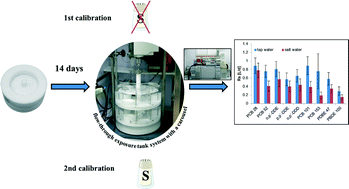Calibration of Chemcatcher® passive sampler for selected highly hydrophobic organic substances under fresh and sea water conditions†
Abstract
This study presents sampling rates (Rs) of the nonpolar Chemcatcher® for selected polybrominated diphenylethers (PBDEs), polychlorinated biphenyls (PCBs) and organochlorine pesticides measured in two calibration experiments with fresh water and salt water (2.5% NaCl), respectively. The uptake experiments were performed with samplers on a carousel in a flow-through tank system at constant concentration of test substances and a temperature of 13 °C. It was found that the linear flow velocity at the sampler surface calculated based on the rotation speed of the carousel (0.4 m s−1) disagreed with the actual measured velocity using a vane anemometer (0.11 m s−1). The sampling rates Rs of the test compounds were in the range of 0.15 to 0.89 L d−1 and were slightly lower in salt water than in fresh water, showing the minor effect of the salt matrix on the uptake of highly hydrophobic organic compounds. Five performance reference compounds (PRC) were also tested during the tank experiments. A higher offload of PRCs was found in salt water (with elimination rates between 0.034 d−1 and 0.051 d−1) compared to fresh water (elimination rates between 0.017 d−1 and 0.028 d−1). Our study demonstrates the suitability of the Chemcatcher® device for time-integrated monitoring of highly hydrophobic micropollutants dissolved in fresh and salt water down to the lower ng-per-litre range.


 Please wait while we load your content...
Please wait while we load your content...